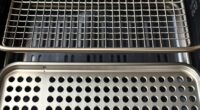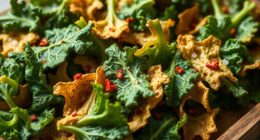To turn stale bread into crunchy croutons, start by choosing a sturdy, slightly dry loaf like baguette or sourdough. Slice the bread evenly and toss it with your favorite oil—olive or butter work well—plus herbs or spices for flavor. Bake at a moderate temperature until golden and crispy, listening for a satisfying crunch. Store your croutons properly to keep them crisp, and discover even more tips for perfect crunchiness as you continue.
Key Takeaways
- Use stale, firm bread like French baguettes or sourdough for best texture and easier cutting.
- Slice bread evenly into cubes, trimming uneven edges for uniform baking.
- Toss bread cubes with oil and seasonings before baking to enhance flavor and crispness.
- Bake at a high temperature (around 375°F) until golden brown and crispy, monitoring for proper color and aroma.
- Store cooled croutons in airtight containers to maintain crunch and prevent moisture absorption.
Selecting the Right Bread for Croutons
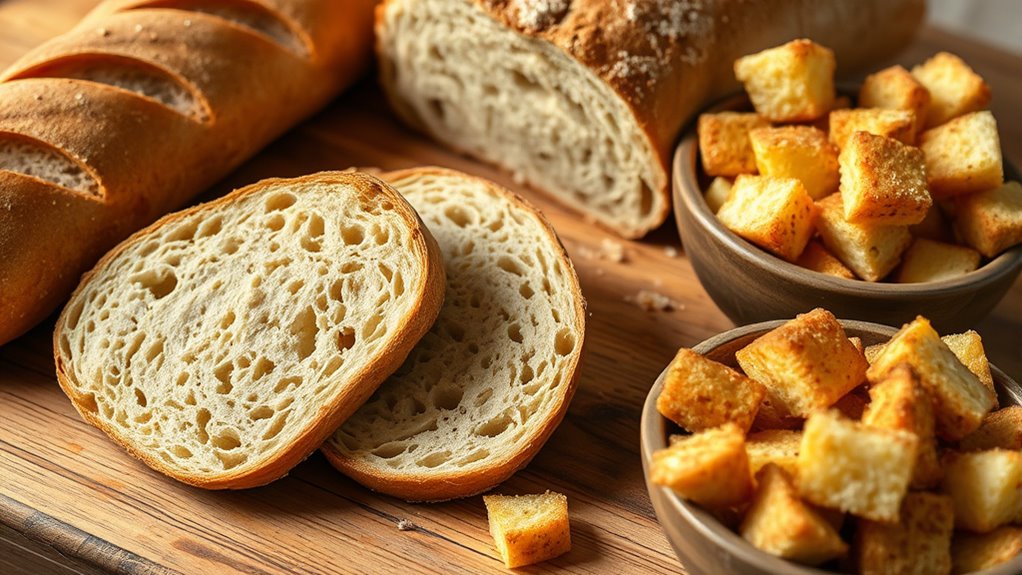
Choosing the right bread is essential for making delicious croutons. When selecting bread types, opt for sturdy options like French baguettes, Italian bread, or sourdough. These hold up well during toasting and develop a satisfying crunch. Avoid soft bread varieties, such as sandwich bread or brioche, which can become soggy. Proper storage tips help preserve bread’s quality—keep it in a cool, dry place or in a paper bag to prevent moisture buildup, which can lead to mold. If you have stale bread, it’s perfect for croutons, but storing it correctly guarantees it doesn’t spoil before use. Additionally, understanding the texture of bread can help you choose the best type for crispiness and flavor. Selecting the right bread and storing it properly ensures your croutons turn out crispy, flavorful, and perfectly textured every time.
Preparing Your Stale Bread Before Baking

Before baking your stale bread into croutons, it’s important to prepare it properly. Check the bread’s freshness; if it’s overly dry or moldy, it’s best to discard it. For bread that’s just a bit stale, consider how you stored it—proper storage tips include keeping bread in a paper bag or bread box to maintain ideal dryness without excess moisture. If your bread is too fresh, let it sit uncovered for a few hours to dry out slightly. Remove any crusts or uneven edges if desired, but avoid wasting good bread. Slicing the bread into even pieces ensures uniform baking. Taking these steps guarantees your croutons turn out crispy and flavorful. Additionally, understanding how automation in business can streamline your kitchen prep or baking process might inspire innovative ways to enhance your cooking routine.
Cutting Techniques for Perfectly Sized Croutons

Using uniform cube cuts guarantees all your croutons cook evenly and look appealing. Pay attention to the slice thickness so the pieces are crispy on the outside but not burned inside. Mastering these cutting techniques makes a big difference in achieving perfect croutons every time.
Uniform Cube Cuts
To achieve perfectly sized croutons, focus on creating uniform cube cuts. Start by selecting bread that’s a bit stale, which makes cutting easier and helps the cubes hold their shape. Pay attention to crust thickness; thicker crusts add crunch but can make cutting uneven. Use a sharp knife and steady, even pressure to guarantee each cut is consistent. First, trim off any uneven edges to create a flat surface, then slice the bread into even strips. Next, cut those strips into uniform cubes, aiming for equal size throughout. Consistent cube cuts help the croutons cook evenly, ensuring a crispy, crunchy texture. Precision here assures every crouton looks good and tastes perfect, making your salad or soup extra delicious.
Precise Slice Thickness
Once you’ve trimmed and sliced your bread into cubes, paying attention to slice thickness guarantees uniform croutons. Consistent thickness ensures even baking and crispy texture. To achieve this, consider these tips:
- Use a sharp serrated knife for clean cuts through bread crusts and soft interiors.
- Aim for slices about 1/2 inch thick, regardless of bread types, for optimal crunch.
- Keep slices steady and uniform by applying gentle, even pressure.
- Adjust thickness if using bread with thicker crusts or denser bread types to prevent uneven baking.
- Recognize how bread texture influences the ideal slice thickness for perfectly crispy croutons.
Matching slice thickness to bread crusts and bread types helps produce perfectly sized, crunchy croutons every time. This precision ensures your croutons are uniformly crisp and delicious.
Seasoning Ideas to Enhance Flavor

Adding the right seasonings can transform plain croutons into a flavorful topping for salads, soups, or snacks. Herb blends like basil, thyme, or oregano add fresh, aromatic notes, elevating the crunch. Spice mixes such as paprika, garlic powder, or cayenne bring warmth and a bit of heat. You can mix herbs and spices to create custom flavors—think Italian, ranch, or smoky blends. For a savory punch, sprinkle with dried rosemary or tarragon. If you prefer a hint of sweetness, try cinnamon or nutmeg. Toss your croutons with these seasonings before baking for even coating. Remember, a little goes a long way; start with small amounts and adjust to taste. Seasoning your croutons creatively makes them more versatile and delicious. Incorporating seasoning techniques can help you develop unique flavor profiles tailored to your preferences.
Choosing the Best Oil or Fat for Crispiness

Choosing the right oil or fat is key to achieving perfectly crispy croutons. The type you select impacts texture and flavor. Here are some options:
Selecting the right fat enhances crouton crunch and flavor, from olive oil to coconut oil.
- Olive oil – Adds a rich flavor and promotes crispiness with its healthy fats.
- Butter – Delivers a buttery taste and helps create a golden, crunchy exterior.
- Vegetable oil – Neutral flavor, high smoke point, ideal for even browning.
- Coconut oil – Imparts a subtle sweetness and crispness, perfect for a tropical twist.
For best results, choose an oil with a high smoke point to prevent burning. Olive oil and butter are popular for their flavor, but vegetable oil offers versatility. Your choice depends on taste preference and desired crunch. Choosing the right oil can also influence the overall healthiness of your croutons, making it an important consideration.
Baking Methods and Temperature Settings
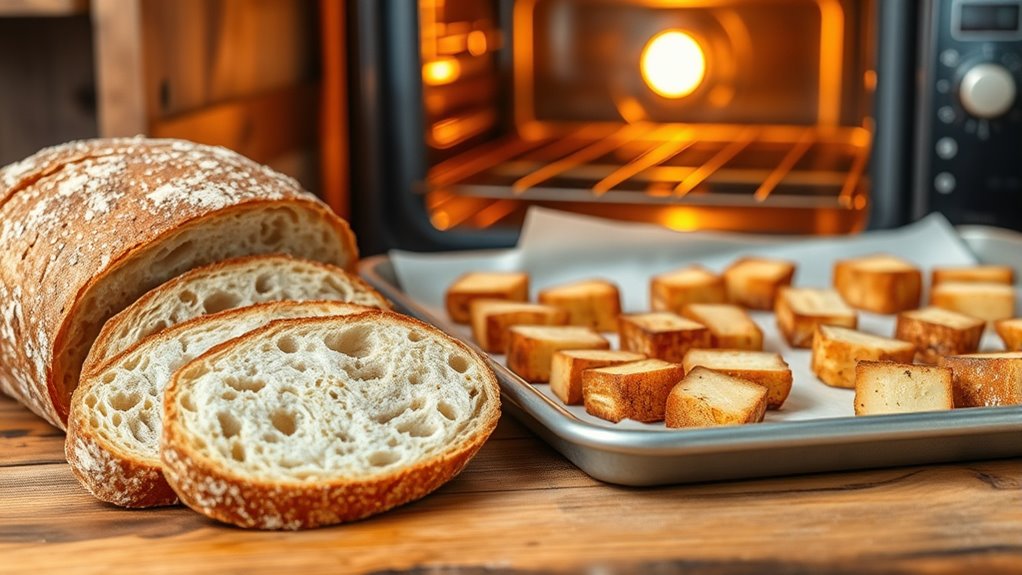
To achieve perfectly crispy croutons, selecting the right baking method and temperature is essential. Start by preheating your oven to guarantee even cooking and maximum crispiness. Proper bread storage keeps your bread stale but not moldy, making it ideal for croutons. Use a single layer baking sheet for uniform heat distribution. For crunchy results, bake at 375°F (190°C) for about 15-20 minutes, flipping halfway. Alternatively, a higher temperature like 400°F (200°C) speeds up crisping but risks burning. Here’s a quick comparison:
| Method | Temperature | Time |
|---|---|---|
| Conventional Oven | 375°F (190°C) | 15-20 mins |
| Broiler Finish | 400°F (200°C) | 8-10 mins |
| Toaster Oven | 375°F (190°C) | 12-15 mins |
Adjust based on your oven and bread dryness. Recognizing angel numbers can also serve as a reminder to be patient during the baking process, trusting that your croutons will turn out just right.
Checking for Doneness and Proper Crispness

You’ll know your croutons are ready when they turn a golden-brown and have a uniform, crispy texture. Tap them lightly—if they make a satisfying crunch, they’re done. Also, check their aroma and color to guarantee they’re perfectly baked without overdoing it. For optimal results, consider the cookie categories that influence how your browser tracks and improves your baking experience.
Visual Texture Indicators
As your croutons near readiness, visual cues become the most reliable way to assess their doneness. You’ll notice that properly crisp croutons have distinct texture indicators that signal they’re ready to remove.
- Golden Brown Color: They should have an even, rich hue, indicating thorough dehydration and flavor enhancement.
- Slightly Raised Edges: Edges may puff slightly and appear crisp, signifying ideal crunch without over-baking.
- Uniform Surface: The surface should look dry and brittle, avoiding any soft or doughy patches that suggest underdone bread preservation.
- No Visible Moisture: The surface must be matte and free of sheen or moisture, confirming they’re crisp and ready to enjoy.
- Consistent Texture: The texture should be uniformly crunchy across the entire surface, which can be influenced by proper oven temperature and even slicing techniques.
These visual indicators help ensure your croutons are perfectly crisp, preserving flavor and texture.
Sound Test for Crispness
Once the visual cues indicate your croutons are close to perfect, giving them a gentle tap or flick provides valuable confirmation of their crispness. This sound test for crispness evaluation reveals whether your croutons are ready or need more time. When they’re properly crisp, they produce a firm, satisfying crunch with a clear, sharp sound. If they’re still soft or dull-sounding, they need additional baking. Pay attention to the noise—an audible snap or crackle signals they’ve reached ideal doneness. Avoid relying solely on appearance; the sound test offers immediate, tactile feedback to prevent underdone or burnt croutons. Mastering this technique helps you achieve perfectly crispy croutons every time, enhancing their texture and flavor. Regularly checking the baking process ensures consistent results and prevents over or under-baking.
Proper Color and Aroma
Monitoring the color and aroma of your croutons is essential for making sure they’re perfectly baked. When checking for doneness, look for a golden-brown hue, which indicates proper crispness. The aroma should be warm and toasty, signaling that flavor enhancement has occurred. To achieve this:
- Keep an eye on the color; avoid over-baking to prevent burning.
- Smell for a fragrant, toasted scent that confirms even baking.
- Use bread stored properly—preferably in a cool, dry place—to guarantee even crisping.
- Remove from the oven once the desired color and aroma are achieved for ideal crunch and flavor.
- Remember that proper storage of bread can significantly influence the quality of your croutons, ensuring consistent results and preventing sogginess. Proper color and aroma not only guarantee crispness but also maximize flavor, transforming stale bread into irresistible croutons.
Storing Your Homemade Croutons
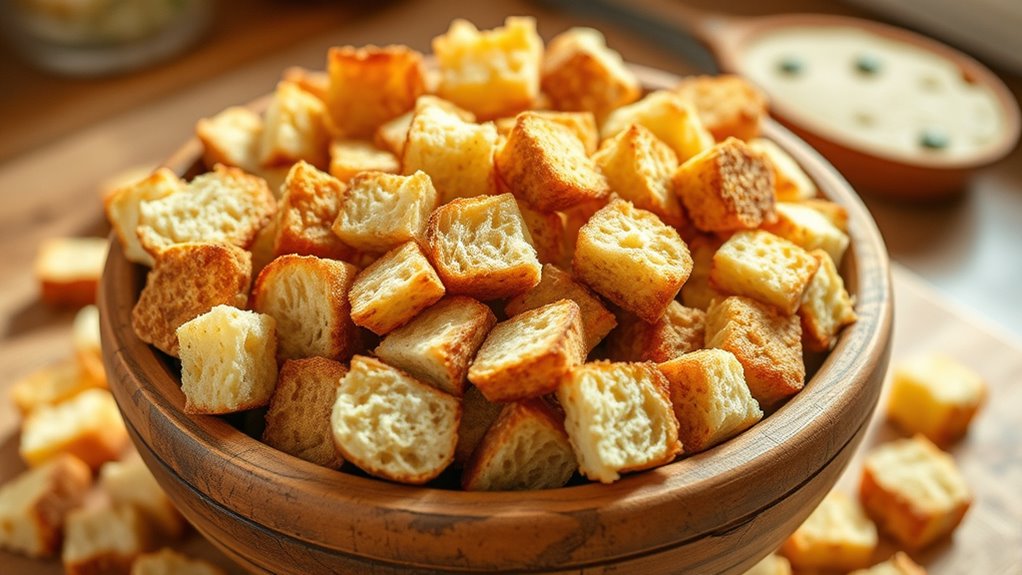
To keep your homemade croutons crispy and fresh, proper storage is essential. Effective bread preservation involves choosing the right storage containers that prevent moisture and air from making your croutons soggy. Use airtight containers or resealable bags to maintain their crunch. Before storing, verify the croutons are completely cooled to avoid condensation, which can cause them to become stale. Keep the containers in a cool, dry place away from direct sunlight to prolong their freshness. Avoid storing croutons near strong-smelling foods, as they can absorb odors. Proper storage not only preserves their texture but also extends their shelf life. With the right approach, your homemade croutons will stay crunchy and delicious for days to come.
Creative Variations and Add-ins

Getting creative with your croutons can elevate their flavor and add a fun twist to your dishes. You can experiment with flavor infusions and unique add-ins to customize them. Here are some ideas:
- Herb and Garlic: Mix chopped rosemary, thyme, or parsley with olive oil and minced garlic for a savory boost.
- Spicy Kick: Add cayenne pepper or smoked paprika to give your croutons a smoky heat.
- Cheese Infusion: Toss with grated parmesan or cheddar before baking for cheesy crunch.
- Sweet Variations: Use cinnamon and sugar for a sweet crunch, perfect for salads or desserts.
These tweaks not only enhance flavor but also improve bread preservation by keeping your croutons flavorful longer.
Delicious Ways to Incorporate Croutons Into Meals

Croutons add a satisfying crunch to salads, making every bite more enjoyable. You can also sprinkle them on soups to boost flavor and texture or use them as a savory topping for pasta dishes. Experimenting with these ideas can elevate your meals and give your dishes a delightful twist.
Salads With Crunchy Texture
Adding crunchy croutons to your salads instantly elevates their texture and flavor, creating a satisfying contrast with fresh greens and tender vegetables. To enhance your salads, consider these tips:
- Use stale bread wisely for bread preservation, ensuring your croutons stay crispy longer.
- Experiment with gluten-free options like gluten-free bread or veggie chips for inclusive meals.
- Toss croutons just before serving to keep them crunchy and prevent sogginess.
- Mix flavors by adding herbs or spices to your croutons for a personalized touch.
Soups for Added Flavor
Incorporating croutons into soups not only boosts their texture but also enhances their flavor profile, making each spoonful more satisfying. The type of bread you choose, like a crusty baguette or a soft sourdough, impacts how well the croutons soak up the broth. A loaf with a dense crumb holds flavor better and maintains crunch longer. The loaf shape also matters—sliced bread provides uniform pieces, while a baguette can be cut into irregular, rustic croutons. Use this table to select the best bread for your soup:
| Bread Type | Ideal Loaf Shape |
|---|---|
| Baguette | Baguette |
| Sourdough | Round or oval |
| French bread | Long, narrow slices |
| Italian bread | Thick slices |
Choose wisely for maximum flavor and crunch.
Pasta Topping Ideas
When you want to elevate your pasta dishes, topping them with crunchy croutons is a simple yet effective strategy. Not only do they add texture, but they also help with bread preservation by repurposing stale bread. Plus, crouton health benefits include added fiber and minerals, making your meal more nutritious. Here are some tasty ideas:
- Sprinkle croutons over a creamy Alfredo or tomato sauce for extra crunch.
- Toss them into cold pasta salads for added texture and flavor.
- Use croutons as a topping for baked pasta casseroles to create a crispy layer.
- Combine with fresh herbs and cheese for a gourmet finishing touch.
These ideas make incorporating croutons into pasta both delicious and health-conscious while reducing waste.
Frequently Asked Questions
Can I Use Gluten-Free Bread for Croutons?
You might think gluten-free bread isn’t the hero for croutons, but it can surprise you! Yes, you can use gluten-free alternatives, and they’ll still turn deliciously crispy if you handle the bread texture right. Just keep in mind, gluten-free breads often have a different texture, so you might need to adjust your baking time. Don’t let that stop you—your salads deserve crunchy, flavorful croutons made from your favorite bread!
How Long Do Homemade Croutons Stay Crispy?
You might wonder how long homemade croutons stay crispy. Typically, they stay crunchy for about 3 to 5 days if stored properly. To maximize their shelf life, keep them in an airtight container at room temperature, away from moisture and heat. Proper bread storage helps maintain freshness, but once exposed to humidity, they can lose their crispness sooner. Enjoy your croutons within this timeframe for the best texture.
Can I Add Cheese or Herbs During Baking?
Did you know that adding cheese or herbs can boost flavor by up to 50%? Yes, you can add cheese additions or herb infusions during baking for delicious croutons. Just sprinkle cheese or herbs on the bread before baking, and they’ll melt or infuse as it crisps. Be careful not to add too much to avoid burning. This method creates flavorful, aromatic croutons perfect for salads or soups.
Is It Better to Bake or Toast Croutons?
When deciding between baking and toasting croutons, baking often offers better flavor enhancement because it allows you to evenly cook and season them. Baking at a moderate temperature lets you add herbs or cheese beforehand, creating a richer taste. Toaster toasting is quicker, perfect for a quick crunch, but it might not develop as much flavor. Choose baking for a more flavorful, evenly crisp result.
How Can I Prevent Croutons From Becoming Too Greasy?
Prevent greasy croutons by balancing bread selection and oil absorption. Choose bread with a sturdy structure, like day-old baguette, to minimize oil uptake. When tossing with oil, use just enough—avoid over-saturating. Spread croutons evenly on a baking sheet, ensuring they don’t overlap to promote even baking. Bake at a high temperature, turning occasionally, until crisp. This careful combination keeps croutons crunchy, not greasy, delivering delightful crunch with controlled oil content.
Conclusion
Now that you know how to turn stale bread into crunchy croutons, think of it like giving old friends a new adventure—they become something delightful again. Just like rediscovering treasures in a forgotten attic, your leftover bread can transform into crispy, flavorful bites that elevate any salad or soup. With a little effort, you’ll turn everyday scraps into kitchen gold, proving that sometimes, the best surprises come from what we almost toss away.

